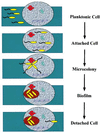Biofilm, city of microbes
- PMID: 10781532
- PMCID: PMC101960
- DOI: 10.1128/JB.182.10.2675-2679.2000
Biofilm, city of microbes
Figures



References
-
- Allison D G, Ruiz B, SanJose C, Jaspe A, Gilbert P. Extracellular products as mediators of the formation and detachment of Pseudomonas fluorescens biofilms. FEMS Microbiol Lett. 1998;167:179–184. - PubMed
-
- Colwell R R, Spira W M. The ecology of Vibrio cholerae. In: Barua D, Greenough W B I, editors. Cholera. New York, N.Y: Plenum; 1992. pp. 107–127.
-
- Costerton J W, Cheng K-J, Geesey G G, Ladd T I, Nickel J C, Dasgupta M, Marrie T J. Bacterial biofilms in nature and disease. Annu Rev Microbiol. 1987;41:435–464. - PubMed
-
- Cowan M M, Fletcher M. Rapid screening methods for detection of bacterial mutants with altered adhesion abilities. J Microbiol Methods. 1987;7:241–249.
Publication types
MeSH terms
LinkOut - more resources
Full Text Sources
Other Literature Sources

